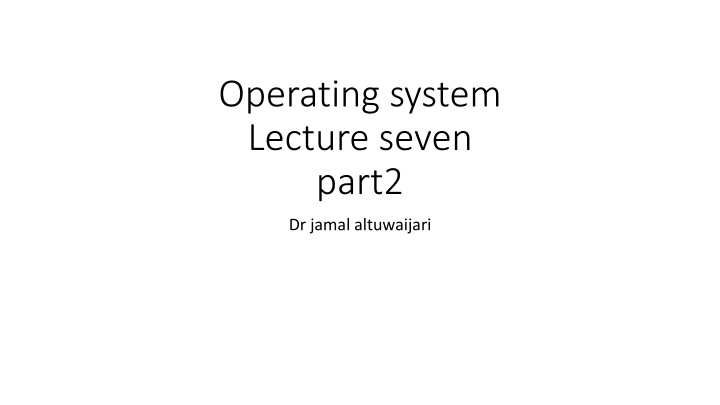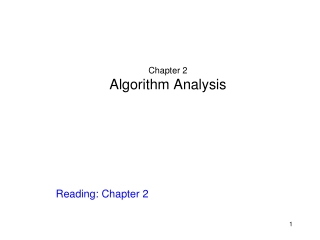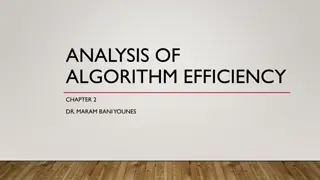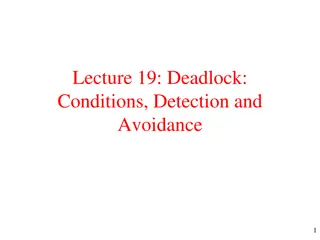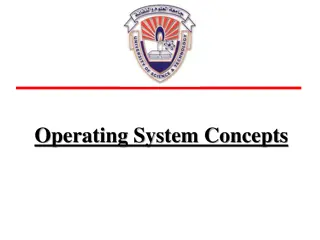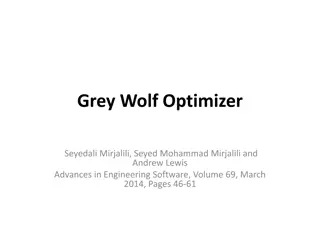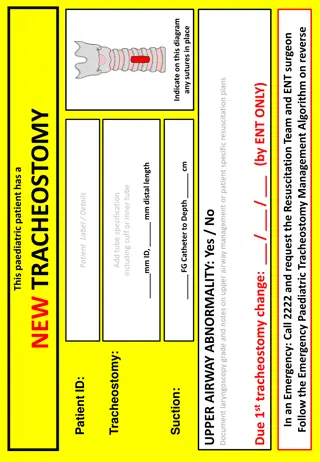Banker's Algorithm and Safety Algorithm
The Banker's Algorithm is used to determine safe resource allocation, while the Safety Algorithm checks if a system is in a safe state by analyzing resource availability and process needs. Learn how these algorithms are applied in operating systems.
Download Presentation

Please find below an Image/Link to download the presentation.
The content on the website is provided AS IS for your information and personal use only. It may not be sold, licensed, or shared on other websites without obtaining consent from the author.If you encounter any issues during the download, it is possible that the publisher has removed the file from their server.
You are allowed to download the files provided on this website for personal or commercial use, subject to the condition that they are used lawfully. All files are the property of their respective owners.
The content on the website is provided AS IS for your information and personal use only. It may not be sold, licensed, or shared on other websites without obtaining consent from the author.
E N D
Presentation Transcript
Operating system Lecture seven part2 Dr jamal altuwaijari
B- Banker's Algorithm Banker's Algorithm If Available [j] = k these are k instances of resource type Rjavailable. Max: An n m matrix defines the maximum demand of each process. If max [i , j] = k , then process pi may request at most k instances of resource type Rj. Allocation: An n m the resources currently allocated to each process. If allocation [i , j]= k then process piis currently allocated process piis currently allocated 1 instances of resources of resource type Rj. Need: An n m matrix indicates the remaining resource need of each process. If need [i , j] =k then process pimay need k more instances of resource type Rjto complete its task. Need [i , j] = Max [i ,j] Allocation [i , j] If request i Need i go to step 2 otherwise raise an error since the process has exceeded its maximum claim If request i Available go to step 3. Otherwise pimust wait since the resources are not available. The system pretends to have allocated the requested resources to process piby modifying the state as follows: Available: = Available - Request i; Allocation i : = Allocation i + Request i; Need i:= Need i - Request i; If the resulting resource allocation state is safe the transaction is completed and process piis allocated its resources . If the new state is unsafe the pimust wait for request i and the old resource allocation state is restored .
C- Safety Algorithm The algorithm for finding out whether or out a system is in a safe state can be described as follows: 1-Let work and finish be vectors of length m and n respectively. -Initialize work:= Available and Finish [i]:=False for i=1, 2, ..., n. 2-Find an i such that both -Finish [i] = false -Need i work -If no such i exists, go to step 4. 3-Work:=work + allocation I Finish[i] :=true go to step 2. 4-If Finish [i] = true for all i then the system is in a safe state. This algorithm may require an order of mxn2operations to decide whether a state is safe.
C- Safety Algorithm This algorithm may require an order of mxn2operations to decide whether a state is safe. Example: Consider a system with five processes {p0, p1 , .., p4 } and three resource types {A, B, C}. Resource type A has 10 instances. Resource type B has 5 instances, and resource type C has 7 instance. Suppose that at time T0the following snapshot of the system has been taken. Allocat Max Availa ion ble A B C A B C A B C P0 P1 P2 P3 P4 0 1 0 7 5 3 3 3 2 2 0 0 3 2 2 3 0 2 9 0 2 2 1 1 2 2 2 0 0 2 4 3 3
C- Safety Algorithm The content of the matrix Need is defined to be max-Allocation and is: Need A B C P0 P1 P2 P3 P4 7 4 3 1 2 2 6 0 0 0 1 1 4 3 1 The system is in the safe state if the processes executed in the sequence <p1 , p3 , p4 , p2 ,p0 >. Suppose now that process p1requests one additional instance of resource type A and two instance of resources type C so request 1 = (1, 0,2). To decide whether this request can be immediately granted we first check that Request 1 Available. (that is, (1, 0, 2) (3 3 2)) which is true we then pretend that this request has been fulfilled and we arrive at the following new state.
C- Safety Algorithm Allocation Max Available A B C A B C A B C P0 0 1 0 7 4 3 2 3 0 P1 3 0 2 0 2 0 P2 3 0 2 6 0 0 P3 2 1 1 0 1 1 P4 0 0 2 4 3 1 By execute the safety Alg. we find the sequence <p1 , p3 , p4 , p0 , p2> satisfies our safety requirements. Hence we can immediately grant the request of process P1. If p4 request for (3, 3, 0). The request can not granted since the resources are not available. Request 1 > Available . If p0 request (0, 2, 0) can not granted even though the resources are available since the resulting state is unsafe.
7.4.3 Deadlock Detection 7.4.3 Deadlock Detection If a system does not employ some protocol that ensures that no deadlock will ever occur. Then a detection and recovery scheme must be implemented. The system can use an Algorithm to examines the state of the system periodically to determine whether has occurred. If so the system must recover from the deadlock by providing: A- Maintain information about the current allocation of resources to processes and outstanding requests. B- Provide an Alg. that use the above information to determine whether the system has entered the deadlock state.
The detection Alg. employs several time - varing data structures that are very similar to those used in the Banker's Algorithm: - Available. - Allocation. Request. An n m matrix indicating the current request of each process. If Request [i , j]=k then p1is requesting k more instances of resource type rj. The detection Alg. simply investigates every possible allocation sequence for the processes that remain to be completed.
The detection Alg. as follows: 1- Let work and finish be vectors of length m and n respectively. Initialize work:=Available, for i = 1, 2, .. n. If allocation 0 the finish [i]:=false; otherwise, finish [i]:= false. 2- Find an index i such that : - Finish [i] = false, and - Request i work. - If no such i exists go to step 4. 3-Work:=work + Allocation i finish [i]= true go to step 2. 4- If Finish[i] = false, for some i, 1 i n then the system is in a deadlock state. More over, if Finish[i]-false then process piis deadlocked.
Example:- Consider a system with five processes {p0, p1, ...., p4} and three resources types {A=7 instance, B=2, C=6 instance} suppose that at time T0we the following resource allocation state. Allocation Max Available A B C A B C A B C P0 0 1 0 0 0 0 0 0 0 P1 2 0 0 2 0 2 P2 3 0 3 0 0 0 P3 2 1 1 1 0 0 P4 0 0 2 0 0 2
If we execute the detection Alg. we find the system is not in a deadlock state, and the sequence <p0 ,p2, p3, p1, p4> will result in finish [i]=true for all i. Suppose now that process p2makes one additional request for an instance of type C. The Request matrix is modified as follows: Request A B C P0 P1 P2 P3 P4 0 0 0 2 0 2 0 0 1 1 0 0 0 0 2 We claim that the system is now deadlocked. Although we can reclaim the resources held by process p0 the number of available resources is not sufficient to fut fill the requests of the other processes. Thus a deadlock exist, consisting of processes <p1, p2 , p3 , and p4 >.
-Single Instance of each resource type The Detection Alg. is of order mxn2. If all resources have only a single instance we can define a faster Alg. we will use a variant of the resource allocation graph called a wait for graph. This graph is obtained from the resource allocation graph by removing the nodes of type resource and collapsing the appropriate edges. Where the edge from pito pjin a wait for graph implies that process pi is waiting for process pjto release a resource that it needs. An edge (pi , pj) exists in a wait-for graph if and only if the resource RAG contains two edges (pi , rq) and (rq, pi) for some resource, see figure 7.8.
A deadlock exists in the system if and only if the waitfor graph contains a cycle.
Recovery from Deadlock When a detection Alg. determines that a deadlock exists the system must recover from the deadlock. There are two options for breaking a deadlock. A- Process termination by killing a process, two methods: - Kill all deadlocked processes. - Kill one process at a time until the deadlock cycle is eliminated. B- Resource preemption, to eliminate deadlocks using resource preemption we can preempt some resources front processes and give them to other processes until the deadlock cycle is broken. If preemption is required in order to deal with deadlocks then three issues need to be addressed: - Selecting a Victim: Which process and which resources. - Rollback: If we preempt a resource from a process what should be done with that process? - Starvation: How do we ensure that Starvation will not occur? That is how can we guarantee that resources will not always be preempted from the some process?
